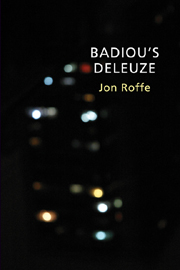1 - The history of a disjunctive synthesis
Summary
Over what were to be the final years of his life, Gilles Deleuze engaged in a long written correspondence with Alain Badiou. Badiou, in the light of his magnum opus Being and Event (L'Être et l'événement), published in 1988, had come to see Deleuze's philosophical project as the closest among those of his contemporaries to his own, and in turn saw Deleuze as his key rival in the attempt to present a philosophy of multiplicity and immanent being. This correspondence, unfortunately never published owing to Deleuze's dissatisfaction with its abstract tone (DCB 6/14), concluded at the end of 1994, shortly before the latter's death. In 1997, Badiou published Deleuze: The Clamor of Being (Deleuze: Le clameur de l'Être), which was a final letter to Deleuze, a summary of their epistolary disagreements and a restatement of the critical appraisal of Deleuze's thought first expressed directly to Deleuze himself.
The Clamor of Being is presented as a work of demystification, an attempt to reinstate a classical image of the latter's philosophy in the face of a pervasive attempt to cast him as a thinker of “the heterogeneous multiplicity of desires” (DCB 8/17): in place of the caricature, “A faithful portrait of the master” (DCB xii). The central claim of this work is infamous: that Deleuze, far from being a philosopher dedicated to propounding the fundamental status of multiplicity and difference, is rather concerned with the ultimate status of ontological unity: “Deleuze's fundamental problem is most certainly not to liberate the multiple but to submit thinking to a renewed concept of the One” (DCB 10/19).
- Type
- Chapter
- Information
- Badiou's Deleuze , pp. 1 - 5Publisher: Acumen PublishingPrint publication year: 2011



